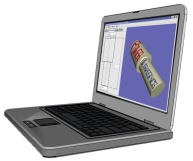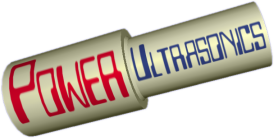A new online ultrasonics components store has just opened at www.UltrasonicsWorld.com. Check their amazing prices for replacement ultrasonics components, fully compatible with the major manufacturers' originals at a fraction of the cost.
You are here
Reg ultrasonic machining
Sir, I've some doubts regarding ultrasonics and their application to machining. Kindly clarify them.
1. I saw some ultrasonic machine tools specifying the range of frequency in which they operate. say--- 17 to 21 khz. In such case how can the transducer be tuned to operate at resonant condition over
entire range? Also as you answered to some query, is removing material here and there is the only method of tuning??
2. Generally amplitude is specified in terms of % of power like 40% or 50% power. Does it mean only that much % of rated power is being consumed?? Also can you please tell/refer to any relation(s) between input power and amplitude.
3. Sir, if you don't think otherwise, can you please elaborate the resonant condition of standing wave? I mean at the interface when the wave gets reflected back and forms a standing wave, I'm thinking it is getting exactly out of phase with incident wave. So won't this nullify the incident wave? I know I'm interpreting it wrongly
somewhere cos in practice it is not getting nullified but getting resonated.


Re: Reg ultrasonic machining
Hello Kiran. Thanks for posting this on the board so I can answer it publicly.
[color=Blue]1. I saw some ultrasonic machine tools specifying the range of frequency in which they operate. say - 17 to 21 khz. In such case how can the transducer be tuned to operate at resonant condition over entire range?[/color]
This is really one for the equipment manufacturers to answer, but here goes: In an ideal situation all mechanical components should be resonant at the same frequency - then the resonant frequency of the complete 'stack' will also be the same and all joints between components will be precisely at the amplitude antinodes. This is good because these points are also stress nodes, so if a stud is used to join the components then it won't be stressed.
In practice this perfect condition is never achieved - there's always some difference between the individual components' resonant frequencies and the resonant frequency of the complete system will be somewhere in between, ie. the system will operate over a range of frequencies. It's up to individual manufacturers to decide how much of a range their equipment can tolerate. This will depend on both mechanics (how much stress can that joining stud tolerate without fatigue?) and electrics / electronics (the system used by the generator to maintain resonance).
Would any manufacturers care to comment further?
[color=Blue]Also as you answered to some query, is removing material here and there is the only method of tuning??[/color]
Mechanical resonance depends on shape, size and material properties. Assuming you have an existing component then material properties are fixed, so tuning involves changing shape or size - how else could you do it?
Size can generally only be reduced (unless you're prepared to start welding bits on!), so is normally changed only as a way to increase the resonant frequency. Hence shape changes are often used to reduce the resonant frequency - eg. changing from a straight rod to a dumbell shape will reduce the resonant frequency because mass is concentrated at the ends and stiffness is reduced in the centre. This is the basis for reducing the resonant frequency of a sonotrode by removing material in the middle.
[color=Blue]2. Generally amplitude is specified in terms of % of power like 40% or 50% power. Does it mean only that much % of rated power is being consumed?? Also can you please tell/refer to any relation(s) between input power and amplitude. [/color]
Amplitude NEVER relates to power in such a simple way! In general there are 2 types of system you may come across: constant amplitude and constant power.
In a constant power system (eg. for ultrasonic cleaning or liquid processing, where the load is fairly constant) you may have a control to adjust power input up to (presumably) the rated power. In this case you have no control over amplitude; it will be whatever the loading permits, probably with a pre-set limit that protects the transducer from mechanical damage.
In a constant amplitude system (eg. for plastic welding or other processes with dramatically changing loads) you may have a control to adjust amplitude as a percentage of nominal but in this case you have no control over power - the generator supplies as much power as necessary to maintain the set amplitude ("power by demand"). If the power demanded is greater than the generators capacity (or rated power) it will cut out.
One further complication is that the power factor of ultrasonic systems varies greatly as the mechanical system changes between resonant / non-resonant and loaded / unloaded states - ie. the phase angle between voltage and power changes. This makes accurate measurement of true power a bit of a challenge. You'll find terms like 'reflected power' used when you have high voltage and current with a near 90 degree phase angle.
[color=Blue]3. Sir, if you don't think otherwise, can you please elaborate the resonant condition of standing wave? I mean at the interface when the wave gets reflected back and forms a standing wave, I'm thinking it is getting exactly out of phase with incident wave. So won't this nullify the incident wave? I know I'm interpreting it wrongly
somewhere cos in practice it is not getting nullified but getting resonated.[/color]
With the reflected wave travelling in the opposite direction to the incident wave it's meaningless to talk about phase angles. The two waves always cancel in certain locations (the nodes of the standing wave) but in other locations they combine to give a value that varies as they move. Try drawing 2 waves on tracing paper and moving them in opposite directions under a third (fixed) sheet, summing the amplitude on the top sheet after each move - you should see it...
Personally I don't find the reflected travelling wave model particularly useful anyway - I prefer to imagine a sonotrode as a pair of masses joined by a spring - that way it's easy to imagine the standing wave.
Hope that helps. Feel free to post again if you need anything more specific!
Regards
Chris
Re: Reg ultrasonic machining
Sir, Thank you very much for your detailed reply. My doubts got cleared. I'll be back if i get any doubts.
Kiran